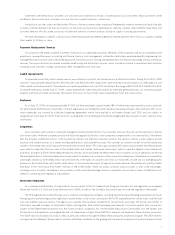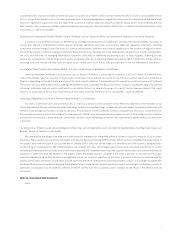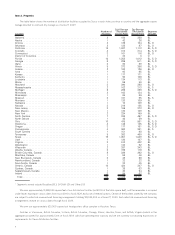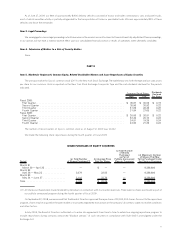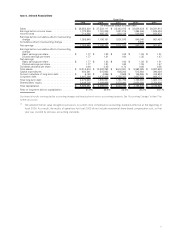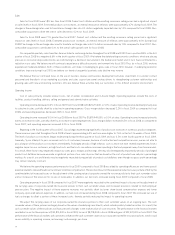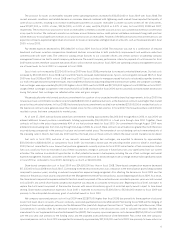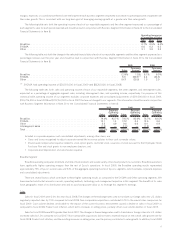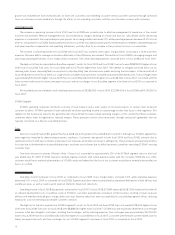Sysco 2009 Annual Report Download - page 32
Download and view the complete annual report
Please find page 32 of the 2009 Sysco annual report below. You can navigate through the pages in the report by either clicking on the pages listed below, or by using the keyword search tool below to find specific information within the annual report.Item 7. Management’s Discussion and Analysis of Financial Condition and Results of Operations
Highlights
We continued to experience a difficult economic environment in fiscal 2009. We believe the deteriorating economic conditions and heightened
uncertainty in the financial markets have adversely impacted consumer disposable income and consumer spending patterns, which in turn is
impacting our industry. Our industry has experienced volatile fuel prices and food costs, and our customers have experienced lower traffic from their
customers. Food cost inflation, which we began to experience at high levels in the fourth quarter of fiscal 2007 and which prevailed through the first
half of fiscal 2009, moderated in the second half of fiscal 2009. These factors negatively impacted sales and operating income in fiscal 2008 and
fiscal 2009. The decline in the financial markets had an additional impact on our operating income because Sysco invests in life insurance policies in
order to provide for certain retirement programs. The value of our investments in corporate-owned life insurance policies is largely based on the
values of underlying investments, which include publicly traded securities. Due to the decline in the financial markets, we have experienced losses in
the cash surrender values of these policies, which has reduced operating income.
Sales decreased 1.8% in fiscal 2009 over the comparable prior year period to $36,853,330,000 primarily due to deteriorating economic
conditions and the resulting impact on consumer spending. Inflation, as measured by product cost increases, was an estimated 4.7% during fiscal
2009. Operating income decreased to $1,872,211,000, or 5.1% of sales, a 0.4% decrease over the prior year. Our operating companies have
continued to manage their businesses effectively in a difficult environment, which is demonstrated by the fact that the decrease in operating income
was less than the decrease in sales. Basic and diluted earnings per share in fiscal 2009 were both $1.77, a decrease of 3.3% and 2.2%, respectively,
from the comparable prior year period. The effective tax rate for fiscal 2009 was negatively impacted by accruals for tax contingencies and the non-
deductibility of the losses recorded on corporate-owned life insurance.
Operating income for fiscal 2009 was negatively impacted by the combined effect of increased losses on the adjustment of the carrying value of
corporate-owned life insurance policies to their cash surrender values and an increase in the provision for losses on receivables.The negative impact
of these additional expenses was more than offset by lower pay-related expenses related to reduced headcount and lower incentive compensation
and operating efficiencies. In addition, our fuel costs increased in fiscal 2009, driven by higher contracted fuel prices as compared to fiscal 2008. We
partially offset the impact of these higher fuel costs through fuel usage reduction measures and fuel surcharges.
Overview
Sysco distributes food and related products to restaurants, healthcare and educational facilities, lodging establishments and other foodservice
customers. Our operations are primarily located throughout the United States, Canada and Ireland and include broadline companies, specialty
produce companies, custom-cut meat operations, hotel supply operations, SYGMA (our chain restaurant distribution subsidiary) and a company
that distributes to international customers.
We consider our primary market to be the foodservice market in the United States and Canada and estimate that we serve about 17% of this
approximately $215 billion annual market. According to industry sources, the foodservice, or food-away-from-home, market represents approx-
imately 48% of the total dollars spent on food purchases made at the consumer level in the United States.This share grew from about 37% in 1972 to
nearly 50% in 1998 and did not change materially until 2008 when it declined to the current level of 48%.
Industry sources estimate the total foodservice market in the United States experienced a real sales decline of approximately 3.6% in calendar
year 2008 and real sales growth of 0.2% in calendar year 2007. Real sales growth and declines do not include the impact of inflation or deflation.
General economic conditions and consumer confidence can affect the frequency of purchases and amounts spent by consumers for food-
away-from-home and, in turn, can impact our customers and our sales. We believe the current general economic conditions, including pressure on
consumer disposable income, are contributing to a decline in the foodservice market. Historically, we have grown at a faster rate than the overall
industry and have grown our market share in this fragmented industry. We intend to continue our efforts to expand our market share and grow
earnings by focusing on sales growth, margin management, productivity gains and supply chain management.
Strategy
We intend to continue to expand our market share and grow earnings through strategies which include:
•Sales growth: We intend to grow sales by gaining an increased share of products purchased by existing customers, development of new
customers, the use of foldouts (new operating companies created in established markets previously served by other Sysco operating
companies), investment in new technologies and a disciplined acquisition program. Our business review program, which is designed to help
our customers grow their business, and the size and expertise of our sales force are key factors in maintaining and growing sales.
•Lowering Procurement Costs: We intend to lower our cost of goods sold by leveraging Sysco’s purchasing power and procurement expertise
and capitalizing on an end-to-end view of our supply chain. Our National Supply Chain initiative is focused on lowering inventory, inbound
freight, product costs, operating costs, working capital requirements and future facility expansion needs at our operating companies while
providing greater value to our suppliers and customers. A component of our National Supply Chain initiative is the use of redistribution
centers (RDCs) which aggregate inventory demand to optimize the supply chain activities for certain products for all Sysco broadline
operating companies in a geographic region. We currently have two RDCs located in Virginia and Florida and have purchased the land for a
third RDC in Indiana.
12



